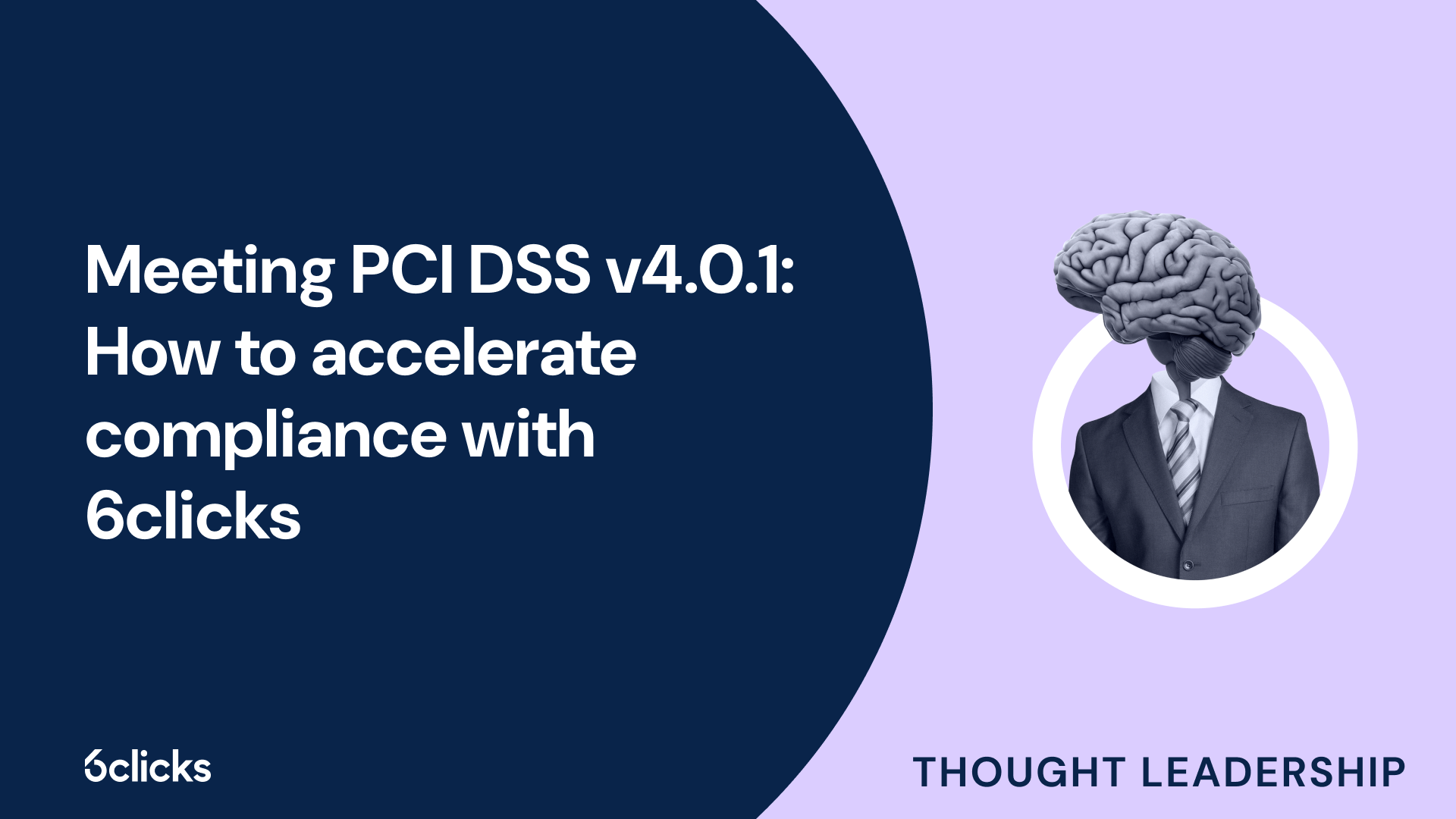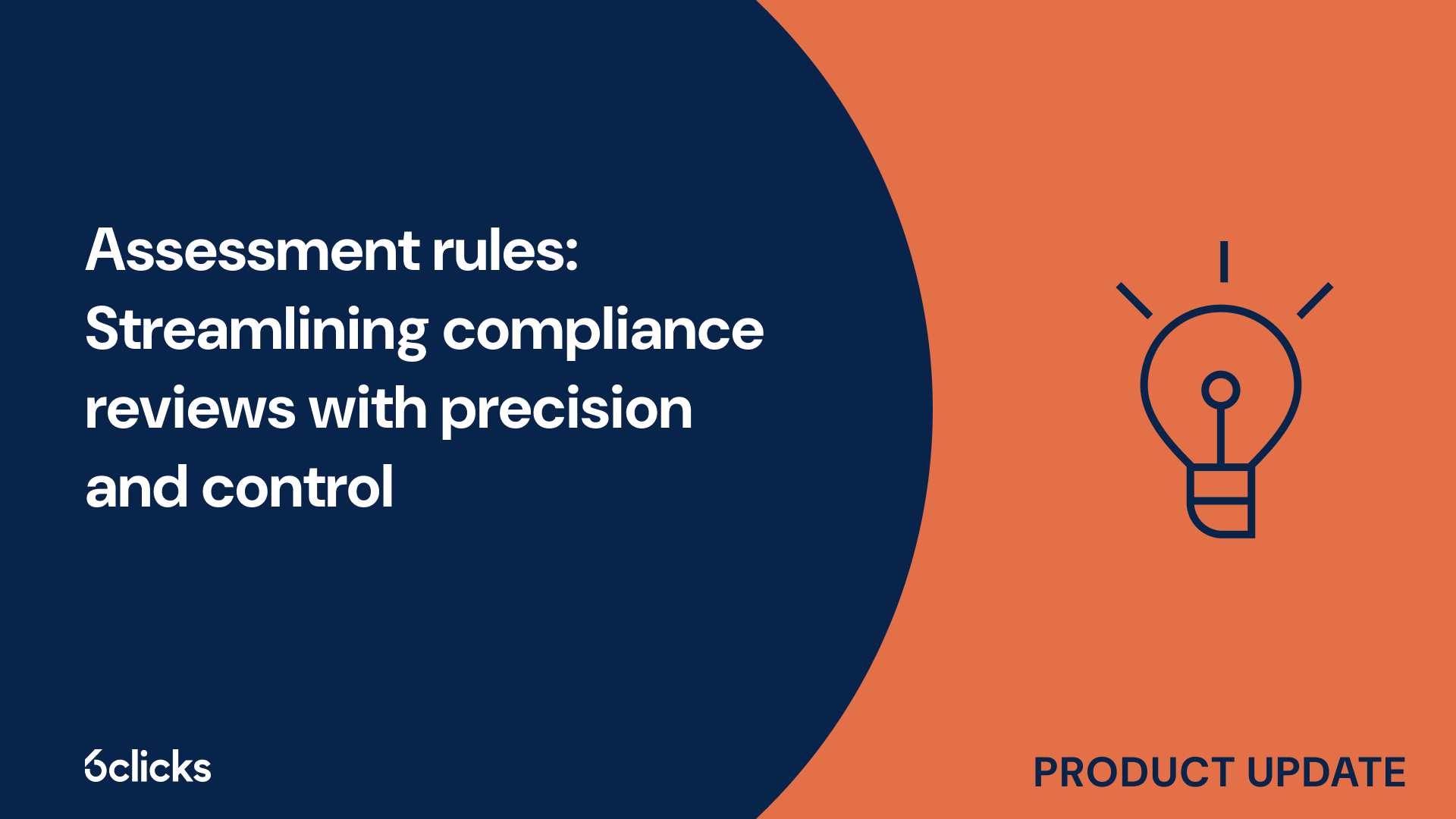The GRC buyer’s guide for 2025: Building resilience with AI-powered, federated solutions
Discover the ultimate GRC buyer's guide for 2025! Uncover how AI-powered, federated solutions transform compliance and security management for industries like government, aerospace, banking, and more. Learn about centralized control, continuous compliance, and advanced cyber GRC capabilities. Download now!
-1.png?width=200&height=249&name=Group%20193%20(1)-1.png)
The GRC buyer’s guide for 2025: Building resilience with AI-powered, federated solutions
What is an ISMS?
An Information Security Management System (ISMS) is a systematic approach to managing sensitive company information to ensure its confidentiality, integrity, and availability. It is designed to establish a structured framework for identifying, assessing, and managing information security risks. The main objective of an ISMS is to protect the organization's information assets from security threats, such as cyber attacks, unauthorized access, and security incidents. By implementing an ISMS, organizations can ensure that they have adequate controls in place to mitigate risks and meet the security requirements of various stakeholders, including customers, partners, and regulatory bodies. An ISMS also provides a holistic approach to information security, encompassing not only technical measures but also organizational controls, physical controls, and access control policies. By continuously monitoring and improving the ISMS, organizations can ensure the ongoing effectiveness of their security measures and meet the ever-evolving security threats and business requirements.
What are the 3 security objectives of an ISMS?
The three security objectives of an Information Security Management System (ISMS) are confidentiality, integrity, and availability.
Confidentiality refers to protecting sensitive information from unauthorized access and disclosure. This includes both personal and corporate data. Threats to confidentiality include unauthorized access, data breaches, and cyber attacks. Strategies to achieve confidentiality include implementing access control policies, using encryption and password protection, and regularly training employees on data protection practices. The benefits of maintaining confidentiality include maintaining trust with customers and partners, compliance with privacy laws, and protecting intellectual property.
Integrity is about ensuring the accuracy and completeness of information and protecting it from unauthorized alteration. Threats to integrity include data manipulation, malicious alterations, and unauthorized changes. Strategies to achieve integrity include implementing security controls, ensuring data backups, and regularly testing and verifying data. The benefits of maintaining integrity include trust in data accuracy, prevention of fraud or data tampering, and compliance with industry regulations.
Availability refers to ensuring that information and systems are accessible and operational when needed. Threats to availability include system failures, natural disasters, and cyber attacks. Strategies to achieve availability include implementing backup systems, investing in redundancy and failover measures, and conducting regular maintenance and updates. The benefits of maintaining availability include uninterrupted business operations, customer satisfaction, and minimal downtime.
By focusing on these three security objectives, organizations can establish a robust and comprehensive ISMS to protect their information assets and mitigate the risks associated with data breaches and other security incidents.
Security objective 1: confidentiality
Confidentiality is one of the three key security objectives that organizations strive to achieve when implementing security measures. It involves protecting sensitive information from unauthorized access and disclosure, whether it is personal data or corporate information. Unauthorized access, data breaches, and cyber attacks are potential threats to confidentiality that organizations face. To maintain confidentiality, businesses can implement access control policies, utilize encryption and password protection, and consistently train employees on data protection practices. Achieving and maintaining confidentiality offers numerous advantages, such as building trust with customers and partners, ensuring compliance with privacy laws, and safeguarding intellectual property. By prioritizing confidentiality, organizations can mitigate the risks associated with unauthorized access and breaches and establish a strong foundation for data protection.
Definition of confidentiality
Confidentiality is a fundamental principle in information security and plays a vital role in an Information Security Management System (ISMS). It involves safeguarding and preserving the privacy of information assets and systems from unauthorized access or disclosure.
In the context of an ISMS, confidentiality focuses on ensuring that sensitive information is only accessible to authorized individuals who have been granted the necessary privileges. This entails implementing measures to control and restrict data access, protecting it from unauthorized users or malicious entities.
To achieve confidentiality, organizations employ a range of techniques and security controls. Encryption is one such measure, which involves encoding data to prevent unauthorized individuals from understanding or accessing it. Additionally, setting strong passwords and implementing access control policies help limit data access to authorized personnel.
By implementing confidentiality measures within an ISMS, organizations can effectively safeguard their information assets and systems. This not only complies with regulatory and contractual requirements but also helps mitigate the risk of theft, unauthorized access, or disclosure of sensitive information. Ultimately, confidentiality is essential to maintaining trust and confidentiality with customers, partners, and stakeholders.
Types of confidentiality threats
In an Information Security Management System (ISMS), organizations face various types of confidentiality threats that can compromise the security of their information assets and systems. These threats can be internal or external in nature and arise from both intentional and unintentional actions.
One common type of confidentiality threat is unauthorized access. This occurs when individuals gain access to sensitive information without proper authorization or privileges. It can result from weak access controls, insufficient authentication mechanisms, or the exploitation of vulnerabilities in systems or applications.
Another threat is data leakage, which happens when sensitive information is unintentionally disclosed to unauthorized individuals or entities. This can occur through human error, such as sending sensitive data to the wrong recipient, or through technical vulnerabilities, such as unsecured communication channels or insecure storage systems.
A third type of threat is espionage, where malicious individuals or organizations intentionally seek to gain access to confidential information for their own benefit or to harm the targeted organization. This can manifest as cyber espionage, where hackers infiltrate networks to access sensitive data, or physical espionage, where individuals steal or gain physical access to confidential documentation or devices.
These types of confidentiality threats can have significant impacts on the security of information assets and systems. Unauthorized access can lead to breaches of sensitive data, loss of intellectual property, or compromise of customer information, resulting in financial loss, reputational damage, and legal ramifications. Data leakage can result in the loss of competitive advantage, damage to customer trust, and non-compliance with legal and regulatory requirements. Espionage can lead to the loss of sensitive information, trade secrets, and critical business intelligence.
To mitigate these threats and ensure confidentiality in an ISMS, organizations should implement robust access controls, encryption mechanisms, secure communication channels, and regular security awareness training for employees. This layered approach helps protect information assets from unauthorized access, data leakage, and espionage, safeguarding the organization's reputation, financial stability, and legal compliance.
Strategies for achieving confidentiality in an ISMS
Confidentiality is a critical objective of an Information Security Management System (ISMS), ensuring that sensitive information remains protected from unauthorized access and disclosure. Here are some key strategies and practices that can be implemented to achieve confidentiality within an ISMS:
- Encryption: Implementing encryption techniques is crucial in safeguarding sensitive information. By encrypting data at rest and in transit, organizations can ensure that even if unauthorized individuals gain access to the data, they will be unable to understand or utilize it without the encryption key.
- Access Control Policies: Establishing comprehensive access control policies helps prevent unauthorized access to sensitive information. This includes defining user roles and privileges, implementing strong authentication methods (e.g., multi-factor authentication), and regularly reviewing and updating access rights.
- Regular Audits: Conducting regular audits is essential to assess the effectiveness of security controls and identify any potential vulnerabilities. Audits provide organizations with insights into their information security posture, enabling them to address weaknesses and enforce policy compliance.
- Antivirus Software and Firmware Components: Implementing robust antivirus software and regularly updating firmware components help protect against malware and other security threats. These measures play a vital role in preventing unauthorized access to sensitive information by detecting and mitigating potential security risks.
- Physical Controls: Organizations should not overlook the importance of physical controls to ensure confidentiality. Implementing measures such as alarm systems, restricted access areas, CCTV surveillance, and secure storage facilities add an extra layer of protection for sensitive information, both in digital and physical formats.
Risk management is an essential aspect of ensuring confidentiality in an ISMS. It involves identifying potential risks, assessing their likelihood and impact, and implementing adequate controls to mitigate them. By prioritizing and implementing appropriate security controls, organizations can maintain the confidentiality of their sensitive information and protect their organizational assets from unauthorized access and disclosure.
Benefits of achieving confidentiality in an ISMS
Achieving confidentiality in an Information Security Management System (ISMS) brings several benefits, including the protection of sensitive information and prevention of unauthorized access. By implementing robust security controls and measures, organizations can establish a secure environment to safeguard their valuable data.
One of the primary advantages of maintaining confidentiality is compliance with industry regulations such as the Health Insurance Portability and Accountability Act (HIPAA) and the General Data Protection Regulation (GDPR). These regulations require organizations to protect sensitive information, and failure to comply can result in severe financial penalties and legal consequences. Protecting the confidentiality of data ensures that organizations meet these regulatory requirements and avoid legal complications.
A confidentiality breach can have profound consequences for organizations. Financial losses incurred due to legal fines, legal costs, and loss of business can be significant. Additionally, the damage to the organization's reputation can be irreparable, resulting in a loss of customer trust and potential business opportunities. By prioritizing confidentiality and preventing unauthorized access, organizations can mitigate these risks and maintain a positive image in the market.
Implementing security controls and measures is essential to safeguard confidentiality. Encryption techniques, access control policies, regular audits, antivirus software, and physical controls are some of the measures that organizations can adopt within their ISMS to protect sensitive information. By adopting a systematic approach and implementing these measures, organizations can ensure that their data remains confidential and secure from unauthorized access.
Security objective 2: integrity
The second security objective that organizations need to prioritize is integrity. Ensuring the integrity of data means that it remains accurate, complete, and unaltered throughout its lifecycle. Maintaining data integrity is crucial for organizations as it helps to prevent unauthorized or accidental modifications, ensuring that information is reliable and trustworthy. In this section, we will explore the significance of data integrity, the potential risks and consequences of a breach, and the measures that organizations can implement to safeguard the integrity of their information. By prioritizing data integrity, organizations can maintain the accuracy and trustworthiness of their data, enhancing decision-making processes and building confidence among customers and stakeholders.
Definition of integrity
Integrity is one of the three fundamental security objectives in information security. It ensures that data is accurate, reliable, and secured against unauthorized changes, tampering, destruction, or loss.
In the context of information security, integrity refers to the trustworthiness and consistency of data throughout its lifecycle. It requires that information remains complete, unaltered, and reliable, maintaining its intended meaning and value.
Integrity measures are vital in protecting data from unauthorized modifications or tampering, which could compromise its accuracy and reliability. By enforcing integrity controls, organizations can prevent or detect any unauthorized changes, ensuring that data maintains its integrity.
Protecting data integrity involves implementing various security measures, such as access controls, encryption, and regular backups. These measures not only prevent unauthorized access to data but also safeguard it against accidental or malicious alterations.
Furthermore, integrity ensures that the information remains trustworthy and reliable for decision-making processes. Organizations rely on accurate and uncorrupted data to maintain business operations, compliance, and customer trust.
Types of integrity threats
Types of integrity threats that can impact an information security management system (ISMS) include unauthorized modification, data corruption, and malicious code injection. Unauthorized modification refers to unauthorized changes made to data, software, or systems without proper authorization. This can include altering the content or structure of files, databases, or configuration settings. Data corruption refers to the unintentional or intentional alteration of data, resulting in the loss of integrity and reliability. This can occur due to software bugs, hardware failures, or malicious actions. Malicious code injection involves the insertion of unauthorized code or scripts into a system or application, with the intention of compromising its functionality, stealing or manipulating data, or causing system and network disruptions.
These integrity threats can have significant consequences for an organization's assets. Unauthorized modification can lead to the manipulation or destruction of critical data, compromising the accuracy and reliability of business operations. Data corruption can result in the loss or degradation of data quality, affecting decision-making processes, compliance, and customer trust. Malicious code injection can introduce vulnerabilities and exploits, leading to unauthorized access, data breaches, and potential disruption of services.
To mitigate these threats, organizations should implement a comprehensive set of security controls and practices. This includes implementing access control policies, regularly monitoring and auditing systems and data, employing antivirus software and firewalls, conducting regular backups, and ensuring the secure coding and development of software. Implementing these measures helps protect the integrity of organizational assets and preserves the trustworthiness and consistency of data within the ISMS.
Strategies for achieving integrity in an ISMS
To ensure the accuracy and completeness of information and protect against integrity threats, organizations need to implement strategic measures as part of their Information Security Management Systems (ISMS). These strategies can help maintain data integrity, safeguard critical assets, and preserve customer trust.
One key strategy is the implementation of robust access controls. By implementing access control policies and procedures, organizations can restrict unauthorized access to sensitive information and prevent unauthorized modification. This includes granting access to authorized personnel only, implementing strong password policies, and regularly reviewing and updating user access levels.
Another important strategy is the use of data validation techniques. Organizations should implement processes to verify the accuracy and completeness of data at various stages, including input, processing, and output. This can involve data validation checks, such as format, range, and content checks, to ensure that only valid and reliable data is processed and stored.
Backup and recovery mechanisms are also critical for achieving integrity in an ISMS. Regularly backing up data and implementing effective disaster recovery plans helps ensure that data can be restored in the event of a security incident or system failure. This not only helps protect against integrity threats but also supports business continuity by minimizing downtime and data loss.
Additionally, organizations should establish robust change management processes. This involves documenting and tracking any changes made to systems, software, or configurations. Implementing thorough change management processes helps ensure that any modifications are authorized, tested, and properly documented, reducing the risk of unintended consequences or integrity breaches.
By implementing these strategies, organizations can achieve integrity in their ISMS, protecting data, preserving its accuracy and completeness, and maintaining customers' trust in their services. These measures also align with industry standards and best practices, such as ISO/IEC 27001, ensuring a systematic and structured approach to information security management.
Benefits of achieving integrity in an ISMS
Achieving integrity in an Information Security Management System (ISMS) has numerous benefits for organizations. By ensuring the confidentiality, availability, and integrity of data, organizations can better protect themselves against various security threats and risks.
Firstly, integrity helps to maintain the confidentiality of data. By implementing robust access controls, organizations can limit access to authorized personnel only, preventing unauthorized individuals from viewing or accessing sensitive information. This reduces the risk of data breaches and unauthorized disclosures, protecting the confidentiality of valuable data.
Secondly, integrity ensures the availability of data. By implementing backup and recovery mechanisms, organizations can minimize downtime and data loss in the event of a security incident or system failure. This helps maintain the availability of critical information, enabling business operations to continue uninterrupted.
Furthermore, integrity safeguards the integrity of data itself. By implementing data validation techniques, organizations can ensure the accuracy and reliability of data at various stages. This helps to prevent data corruption, manipulation, or tampering, protecting the integrity of information from unauthorized modifications.
Moreover, achieving integrity in an ISMS increases resilience against cyberattacks. By following the ISO 27001 standard, organizations are equipped with a systematic and structured approach to security management. This includes risk assessments, implementing security controls, and responding to emerging security threats. By continually improving their security practices, organizations can better protect their information assets from cyber threats.
Lastly, achieving integrity in an ISMS can lead to cost savings for organizations. By proactively addressing security risks, organizations can reduce the likelihood of security incidents or breaches, which can be costly to remediate. Additionally, by adhering to international standards and best practices, organizations can avoid fines, penalties, and legal consequences associated with non-compliance.
Security objective 3: availability
Availability is one of the key objectives of an Information Security Management System (ISMS). It refers to the accessibility and continuous availability of information and information systems to authorized users. By ensuring the availability of data, organizations can maintain smooth business operations and prevent disruptions that may arise from security incidents or system failures. This objective focuses on implementing measures to minimize downtime and data loss, enabling timely access to critical information. Achieving availability in an ISMS involves implementing backup and recovery mechanisms, establishing disaster recovery plans, and implementing robust physical and logical controls. By prioritizing availability, organizations can effectively respond to security incidents, maintain customer trust, and ensure the uninterrupted delivery of products and services.
Definition of availability
Definition of Availability in the Context of an Information Security Management System (ISMS)
In the realm of information security, availability refers to the accessibility and protection of organizational information assets when needed. It is one of the three key objectives of an Information Security Management System (ISMS), alongside confidentiality and integrity.
Availability ensures that information assets are readily accessible to authorized users whenever required, while also safeguarding them against unauthorized access or disruption. This objective encompasses both the physical and logical aspects of information security, aiming to prevent and mitigate any potential risks that could compromise the availability of critical data or systems.
To achieve availability, organizations must employ a systematic and holistic approach that includes implementing appropriate security controls, regularly assessing risks and vulnerabilities, and establishing comprehensive security practices and policies. By doing so, they are better equipped to address various types of threats that could jeopardize the availability of information, such as cyber attacks, unauthorized access attempts, hardware or software failures, natural disasters, or human error.
Continuous availability of information is of paramount importance for business operations. Disruptions or unavailability of critical systems or data can lead to financial loss, reputational damage, regulatory non-compliance, and compromised business continuity. As such, organizations must prioritize the implementation of suitable security measures and continuously monitor and assess their effectiveness to ensure information assets remain available to authorized individuals and systems.
By incorporating availability as a fundamental component of their ISMS, organizations can enhance their ability to protect and maintain the accessibility of vital information assets, ensuring their continuous availability and contributing to the overall success and resilience of the business.
Types of availability threats
There are various types of availability threats that can potentially disrupt an Information Security Management System (ISMS) and impact the availability of data within an organization.
One type of threat is physical damage or loss, which can occur due to natural disasters such as fires, floods, or earthquakes. These events can result in the destruction or inaccessibility of critical infrastructure, including servers, data centers, or network equipment, leading to data unavailability.
Another type of threat is hardware or software failures. Malfunctions in hardware components, such as hard drives or servers, or software glitches can cause system downtime and prevent users from accessing data or services. This can significantly impact business operations and result in a loss of productivity.
Cyber attacks are also a major availability threat. These can include distributed denial-of-service (DDoS) attacks, ransomware, or malicious hacking attempts. Such attacks aim to overwhelm systems, encrypt or steal data, or disrupt network connectivity, rendering data inaccessible or causing service interruptions.
Human error and insider threats can also jeopardize data availability. Accidental deletion or modification of files, improper configuration of systems, or intentional sabotage by employees can lead to data loss or unavailability.
By understanding and mitigating these types of availability threats, organizations can better protect their data and ensure the continuous availability of critical information. Implementing appropriate security controls, backup and disaster recovery plans, and regularly assessing vulnerabilities are essential to minimize the risk of data disruption.







